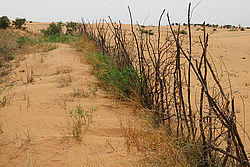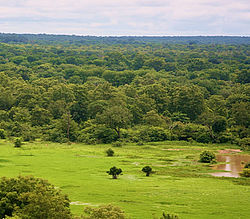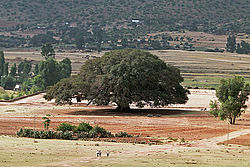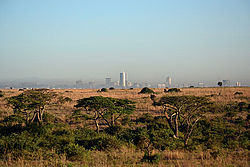Sustainable land management in Africa
How does sustainable land management pay off in Africa?
Sustainable land management practices and their upscaling in Sub-Saharan Africa are essential for a variety of reasons – but the most basic is to sustain and improve livelihoods while protecting the land’s resources and ecosystem functions.
ELD has conducted numerous case studies in Africa which demonstrate that investing in sustainable land management pays off.
Estimates suggest the benefits of taking action against land degradation and desertification to outweigh the cost by almost 7 times.
(ELD Africa Report, 2015)
Take a look at some of our highlights from our studies conducted in Africa.

1
SLM can help slow down or halt the progress of dune fronts
In Niger, it was shown that it is possible to restore the ecological potential of the dunes after one year of fixation and defence. In addition to slowing down the progress of dune fronts, the devices installed protect socio-economic infra-structures, such as roads, water points, basins, pastures, and crop fields from silting up. The installation of anti-erosive clay shelves allows a gradual return of small wildlife. Fodder biomass production and floristic diversity are also improved. Learn more

2
FMNR practices lead to diversified income sources and other benefits
In the impoverished Upper West Region of Ghana, farmers can increase the productivity of their cropland by over 80% within 5 years by using FMNR together with other SLM practices. A typical FMNR farmer in the Lawra District has 33 trees/ha, compared to 13 for their non-FMNR counterparts, including 4 or more different tree species. Farmers earn an additional 4 Ghanaian cedis (GHS) from enhanced forest and crop produce for every GHS invested. Learn more

3
SLM practices lead to greater food security
In Ethiopia, the baseline per capita domestic food crop production at a national level was 348kg in 2016 and declined to 316kg by 2020. The figure will further drop to 256kg by 2030 under the business-as-usual scenario. By investing in SLM technologies, the country has the potential to increase agricultural productivity from 1.89 to 9.92 t/ha/year. Learn more

4
There is no one-size-fits-all SLM approach, but we help identify the best-suited practices for each context
Investigations in the region of Kenya’s Aberdares range show that the SLM practices of vegetative strips, agroforestry and crop rotation, as well as cover crops and organic farming present the most viable SLM options for farmers in the region. Mixed cropping systems, on the other hand, offer comparably low returns. Learn more
